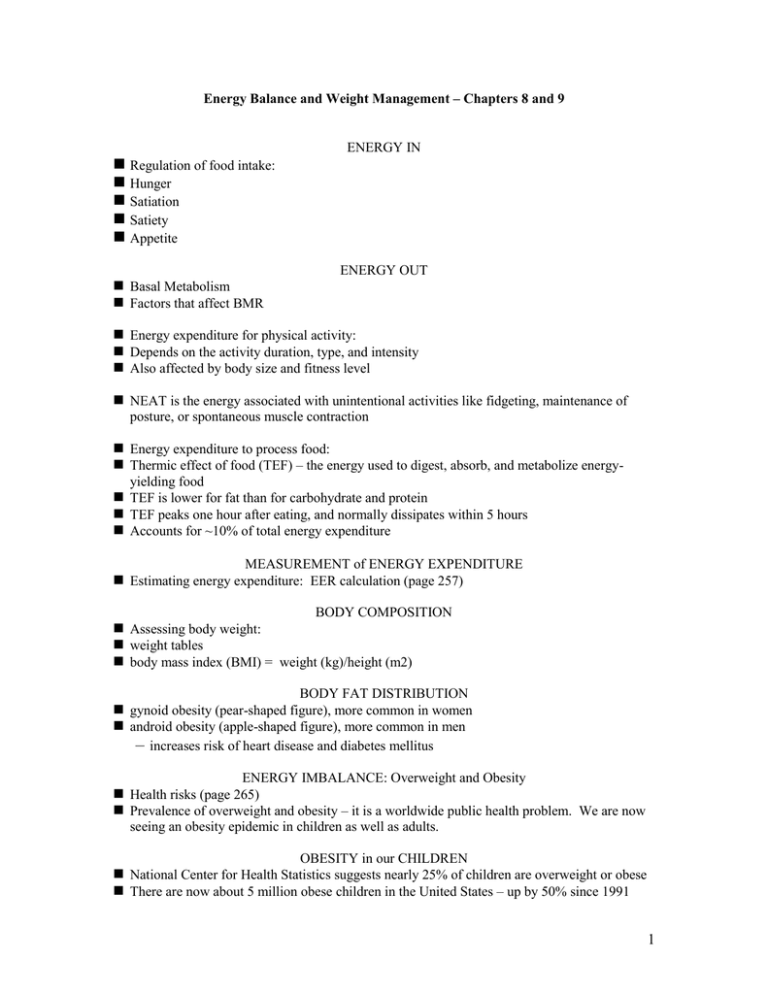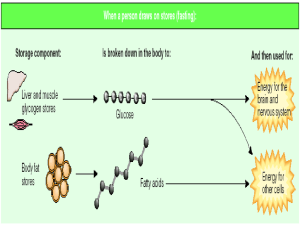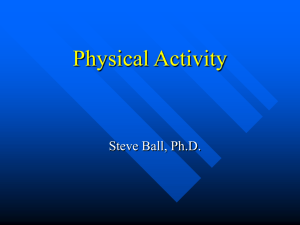advertisement

Energy Balance and Weight Management – Chapters 8 and 9 Regulation of food intake: Hunger Satiation Satiety Appetite ENERGY IN ENERGY OUT Basal Metabolism Factors that affect BMR Energy expenditure for physical activity: Depends on the activity duration, type, and intensity Also affected by body size and fitness level NEAT is the energy associated with unintentional activities like fidgeting, maintenance of posture, or spontaneous muscle contraction Energy expenditure to process food: Thermic effect of food (TEF) – the energy used to digest, absorb, and metabolize energyyielding food TEF is lower for fat than for carbohydrate and protein TEF peaks one hour after eating, and normally dissipates within 5 hours Accounts for ~10% of total energy expenditure MEASUREMENT of ENERGY EXPENDITURE Estimating energy expenditure: EER calculation (page 257) BODY COMPOSITION Assessing body weight: weight tables body mass index (BMI) = weight (kg)/height (m2) BODY FAT DISTRIBUTION gynoid obesity (pear-shaped figure), more common in women android obesity (apple-shaped figure), more common in men – increases risk of heart disease and diabetes mellitus ENERGY IMBALANCE: Overweight and Obesity Health risks (page 265) Prevalence of overweight and obesity – it is a worldwide public health problem. We are now seeing an obesity epidemic in children as well as adults. OBESITY in our CHILDREN National Center for Health Statistics suggests nearly 25% of children are overweight or obese There are now about 5 million obese children in the United States – up by 50% since 1991 1 A 1999 Survey of Seattle High Schools showed that: 9% of males and 6% of females were overweight HEALTH CONSEQUENCES Overweight children and adolescents are more likely to become overweight or obese adults Type 2 diabetes, high blood lipids, hypertension, early maturation and orthopedic problems also occur with increased frequency in overweight youth ECONOMIC CONSEQUENCES In 2000, the total cost of obesity was estimated to be $117 billion Most of the cost associated with obesity is due to type 2 diabetes, coronary heart disease, and hypertension WHAT CAUSES OBESITY? WEIGHT MANAGEMENT- What Works??? Unfortunately, there is no magic pill, no perfect diet. The simple fact is, if you consume more calories than you burn, you will gain weight A slow weight loss (1-2 pounds per week) is the best way To lose 1 pound of fat, you must burn an extra 3500 calories (in one week that = 500 calories per day) Important Components: – – – – – Diet composition Physical activity Behavioral change Balancing acceptance and change Support! DIET COMPOSITION A Healthful Eating Plan Involves: – Realistic energy intake – Nutritional adequacy – Small portions, small frequent meals – Reduced simple sugar and alcohol intake – Adequate water – Physical activity! PHYSICAL ACTIVITY Contributions to weight loss and maintenance: – Direct increases in energy output (muscles and cardiovascular system) – Indirect energy output (elevated BMR) – Appetite control – Psychological benefits Note: Spot reducing is not possible 2 BEHAVIORAL CHANGE Behavior modification: the changing of behavior by the manipulation of antecedents (cues or environmental factors that trigger behavior), the behavior itself, and consequences (the penalties or rewards attached to behavior). SUPPORT • Family • Friends • Weight Loss Support Groups WEIGHT MANAGEMENT Adjuncts to treatment – – – – – Drugs Self-help activities Commercial programs Professional private counselors Surgery: gastric banding, gastric bypass 3


